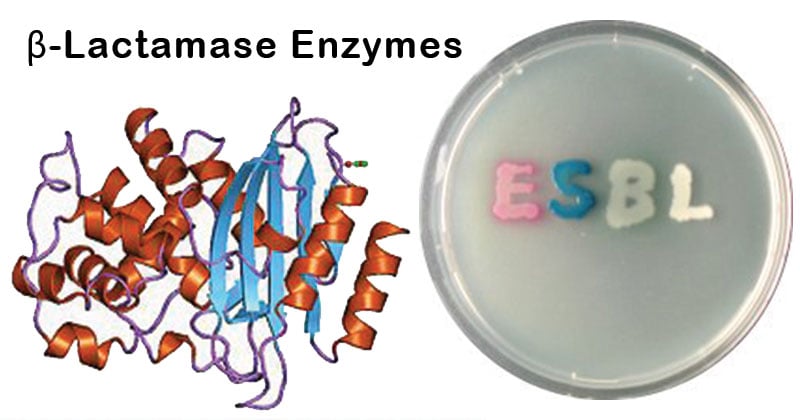β-lactamase enzymes are capable of hydrolysing the β-lactam rings (the active site) of β-lactam antibiotics; thereby deactivating their antibacterial properties.
- It is observed in both gram-positive and gram-negative bacteria.
- They are plasmid coded, and transferred from one bacterium to other mostly by conjugation, (except in Staphylococcus aureus where they are transferred by transduction).
- Beta lactamases can be classified in two ways:
- Ambler’s classification (structural or molecular classification).
- Bush Jacoby Medeiros classification or functional (phenotypic)—Advanced and complex classification.

Interesting Science Videos
Ambler classification of beta-lactamases
Class A-ESBL (Extended spectrum β-lactamases)
Organisms producing ESBL enzymes are resistant to all Penicillins and 1st, 2nd and 3rd generation cephalosporins and monobactams, however remain sensitive to carbapenems and cephamycins.
- Resistance can be overcome by β-lactam + β-lactamase inhibitor (e.g. sulbactum or clavulanic acid).
- Detected by Combination disk test (Ceftazidime and cetftazidime + clavulanic acid), Three dimensional test (best method).
Class B-MBL (Metallo beta-lactamase)
These organisms are resistant to all those antibiotics to which AmpC beta-lactamase producers are resistant plus they are resistant to carbapenems.
- Resistance cannot be overcome by β-lactam + β-lactamase inhibitor combination.
- Detected by EDTA disk synergy test, modified Hodge test.
Class C- AmpC beta-lactamase
These organisms are resistant to all those antibiotics to which ESBL producers are resistant plus they are resistant to cephamycins (e.g. cefoxitin and cefotetan ). But they are sensitive to carbapenems.
- Resistance cannot be overcome by β-lactam + β-lactamase inhibitor combination.
- Detected by AmpC disk test using cefoxitin disk.
Class D- oxacillinase
- Resistance can be overcome by β-lactam + β-lactamase inhibitor combination.

Easily understandable